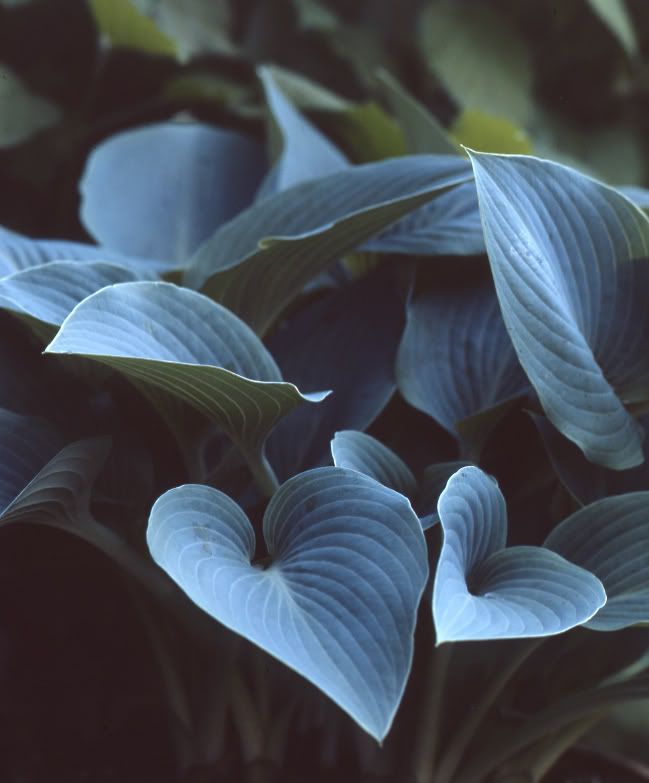
I have, easily 400 hostas in our garden. I have green ones, yellow ones (sometimes called gold), blue ones and variegated ones. Some of the variegated have yellow edges or white edges and are variegated or streaky on the inside. The streaks can be yellow, green or blue or a combination of all three. Some have asymetrical variegation. I even have some really ugly ones like Mildred Seaver's Hosta 'Spilt Milk'. I will never admit to saying this out loud but I tolerate Spilt Milk because Mildred Seaver is dear to me. On any given summer day I will answer the question, "Which is your favourite hosta?" by picking the colour of the day. Of late and only a week ago when Rebecca asked me I told her it was Hosta 'June'. Hosta 'June' is a truly English hosta as it was hybridized (not quite as it was found as a sport or mutant in a bed of Hosta 'Halcyon') in England. It flowers like crazy, it has thick substanced leaves that are imperviuous to munching slugs. It is its variegation that is elegant and striking. All that see it want it. All that see mine specially want it. Many of the Hosta 'June' sold in Vancouver come from American nurseries and they have lost the original understated variegation of the English one. My English June was liberated from England, it traveled to the US and it was given to me for services rendered. It came home in my luggage.
The particular elegance of June has to do with the shape of its leaves. Hosta leaves can be thin and lanceolate or they can be almost round. Some of them can be puckered or dimpled. Some are smooth and some are smooth and shiny. June's leaves are spade shaped and they have an elegant slight curvature in the middle. Some hostas can be so curved as to resemble gourds. In short, Hosta 'June' has everything. That is until I thought about it today.
In the late 60s while working at the famous English nursery of Hilliers of Winchester, architect trained, Southampton born , Eric Smith became its chief propagator. He worked in the walled garden for four years. He came up with new hellebores, bergenias, brunneras, camassia crocosmia, kniphofi and rheums but one cross made him famous. Most hostas flower in June. One in particular Hosta sieboldiana and Hosta sieboldiana 'Elegans' are big and blue with thick leaves. Hosta 'Tardiflora' flowers in Septmeber and has narrow, shiny green leaves. Somehow one of his sieboldianas re-flowered in September do Smith used its pollen to fertilize the Tardiflora's pod. From this cross arose a whole series of mostly blue hostas called called Tardiana (Tardiflora/sieboldiana combined) grex.
Most of these blue hostas inherited the blueness of Hosta sieboldiana with the narrowness of Tardiflora's leaves. Most of the Tardianas have either white flowers like sieboldiana or purple/mauve like Tardiflora.
One of the bluest in my garden is Hosta 'Halcyon'. Another Smith hosta, Hosta 'Camelot' is slightly bluer in my garden but its leaves are just a bit rounder to lose the elegance of Halcyon.
No matter where I place Halcyon, it will be noticed and immediately identified while I may waffle at the names of others and their confusing variegation.

Today while working in the garden and noticing many of my Halcyons I realized that many of my other hostas are flings, exotic flings. Many because of their variegation are hard to keep in good shape. They have less chlorophyll and can be sensitive to too much light or have thinner leaves and are subject to slugs and cut worms.
Not Halcyon. She (she is definitely a she) is tried, true, faithful, stays were it is placed and when placed next to a yellow plant it makes the yellow yellower while appearing itself much bluer. She has only one request and that is that nobody should touch her delicate white/blue coating called bloom. It is sensitive to touch and where you touch it will become green and the blueness will not return until the next season. Not in the least worse for wear, she will be back, unfailingly.
In the picture above, Halcyon is seen in the middle top. To the right is the larger leaved Hosta 'Sieboldiana Elegans'.






